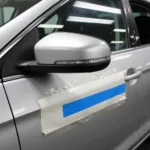Car paint chips are an unfortunate reality of vehicle ownership. Whether it’s a stray rock on the highway, a runaway shopping cart, or an act of nature, these small blemishes can be unsightly and impact your car’s resale value. This begs the question: Does car insurance cover paint chip repair? The answer, like many things in the insurance world, is: it depends. Let’s break down the factors that determine coverage and explore your options for getting those pesky chips fixed.
Understanding Your Car Insurance Coverage
The first step in determining whether your insurance will cover paint chip repair is understanding your specific policy. Car insurance policies vary widely, and not all types of coverage will extend to cosmetic damage like paint chips.
- Comprehensive Coverage: This type of coverage typically covers damage to your vehicle caused by events other than a collision, such as theft, vandalism, fire, or natural disasters. Depending on your policy and the severity of the paint chips, comprehensive coverage might cover the repair costs.
- Collision Coverage: As the name suggests, this type of coverage kicks in if your car is damaged in a collision with another vehicle or object. If the paint chips were a direct result of the collision, your collision coverage should apply.
- Liability Coverage: This is the most basic type of car insurance and is required by law in most states. However, liability coverage only pays for damages you cause to other people’s property and injuries in an accident you cause. It will not cover damage to your own vehicle.
 Reviewing Car Insurance Policy
Reviewing Car Insurance Policy
Factors Influencing Paint Chip Repair Coverage
Even if you have comprehensive or collision coverage, several factors can influence whether your insurance company will cover the cost of paint chip repair:
- Severity of the Damage: A few minor paint chips are less likely to be covered compared to a large area of chipped paint. Some policies have a deductible for comprehensive and collision claims, and the cost of repairing minor chips might be less than your deductible.
- Cause of the Damage: As mentioned, comprehensive coverage typically covers damage from events like vandalism or falling objects. If your insurance company suspects the damage was intentional or due to negligence on your part, they may be less likely to approve a claim.
- Insurance Policy Limits: Your policy will have specific limits on how much the insurance company will pay out for repairs. Check your policy documents to understand these limits and whether they are sufficient to cover the potential cost of paint chip repair.
Should You File an Insurance Claim for Paint Chip Repair?
While it might be tempting to file a claim for even minor paint chips, doing so could have long-term financial implications.
- Increased Premiums: Filing a claim, even a small one, can potentially lead to increased insurance premiums in the future. Insurance companies view drivers who file frequent claims as higher risk.
- Deductible Costs: Remember that you’ll have to pay your deductible before your insurance coverage kicks in. If the cost of repairing your paint chips is less than or slightly more than your deductible, it might not be worth filing a claim.
Alternatives to Insurance for Paint Chip Repair
Fortunately, several alternatives to filing an insurance claim exist for addressing paint chips:
- DIY Repair Kits: For minor chips, DIY paint chip repair kits are available at most auto parts stores. These kits typically contain touch-up paint that matches your car’s color, along with tools for applying the paint and blending it in.
- Professional Paint Chip Repair: If you’re not comfortable with a DIY approach or the damage is more extensive, consider taking your car to a professional detailer or auto body shop specializing in paint chip repair. They have the expertise and tools to achieve a seamless finish.
Getting Quotes and Comparing Costs
Before deciding on the best course of action, get quotes from multiple repair shops or explore the cost of DIY kits. This will help you understand the potential expenses involved and make an informed decision about whether to file an insurance claim or seek alternative solutions.
Tips for Preventing Paint Chips
Prevention is always better than cure. Here are a few tips to help minimize the risk of paint chips on your vehicle:
- Maintain a Safe Following Distance: This gives you more time to react to hazards and reduces the risk of rocks or debris being kicked up by the vehicle in front of you.
- Be Mindful of Road Conditions: Be extra cautious when driving on gravel roads or in areas with construction, as these environments pose a higher risk of flying debris.
- Park Strategically: Whenever possible, park your car in a garage or carport. If you must park outside, choose spots away from trees, construction zones, or areas with high foot traffic.
Conclusion
Dealing with car paint chips can be frustrating, but understanding your insurance coverage and exploring all available options is crucial for making the best decision for your situation. Weigh the severity of the damage, potential insurance implications, and alternative repair methods to determine the most cost-effective and efficient solution.


